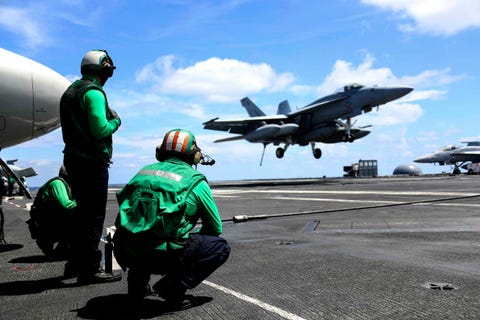The U.S. Navy’s horrible fighter availability rate is gradually improving thanks to increased funding for fighter maintenance. At one point in 2017, just one in three F/A-18 Super Hornet fighters was available, a number that’s increased to nearly half of all fighters. The problem is in large part due to past budget shortfalls and delayed introduction of the F-35 fighter jet.
The U.S. Navy has 546 F/A-18E and F/A-18F Super Hornet fighters, larger, beefier, slightly stealthier versions of the original F/A-18 Hornet. Aircraft readiness rates, or the percentage of aircraft ready for deployment, should typically be north of seventy five percent, depending on type of aircraft, the complexity of the aircraft systems, and the age of the fleet.
In 2017, the Navy’s Super Hornet fleet hovered around 30 percent readiness, a shockingly low number the service blamed on minimal maintenance budgets and non-stop operations. The Navy struggled to place flight-capable aircraft with squadrons deploying on aircraft carriers.
On the outside things looked fairly normal, as carriers went to sea with flight decks filled with Super Hornets. Behind the scenes however non-deployed squadrons suffered, acting as spare parts donors for deployment-bound ships. This cascading effect had negative implications for stateside squadrons and pilot training.
According to DefenseNews, Secretary of the Navy Richard Spencer cited increased maintenance budgets over the past two years as a major part of the turnaround, allowing the service to fund repairs and spare parts. The service also streamlined maintenance processes, avoiding duplication and increasing efficiency.
The maintenance crisis was caused by several problems. The high demand for strike fighters, particularly for combat operations against the Islamic State, increased the amount of wear and tear on the Super Hornet fleet. Super Hornets also act as aerial refueling tankers, increasing flight hours and wear and tear on the platform. Meanwhile the Navy struggled to operate within the budget mandated by the 2011 Budget Control Act that trimmed federal spending. Making matters worse, so-called “continuing resolutions” passed during times of budget bickering to keep government going were an inefficient means of spending money and played havoc with the Pentagon’s budget.
Another problem that indirectly cause the crisis: a delay in the introduction of the U.S. Navy’s version of the Joint Strike Fighter, the F-35C. The F-35C, meant to replace older F/A-18C Hornet fighters, is now at least three years behind schedule. As the chart above illustrates, the Navy originally expected the F-35C to be initial operations capable—when the first Navy squadron is at least partially combat-capable—in late 2015. That date has gradually slipped to late 2018 or early 2019.
As a result of this delay, the Navy was forced to extend the lives of five squadrons of older -C model Hornets while it waited for the F-35C. That work added to the burden of Navy maintenance units already working to keep Super Hornets flying.
In addition to the Navy’s maintenance work, Boeing is set to take 40 to 50 Super Hornets a year and upgrade them to the new Block III configuration. DefenseNews says this will also bring the jets in the worst shape back to flying condition.
In the long term F-35C production should ease the burden on the Super Hornet community, as the fifth generation fighter will eventually equip half of the strike fighter squadrons deployed on U.S. Navy carriers. The executive branch’s 2019 defense budget also plans for an additional 110 Super Hornets over five years. Finally, the Navy plans to acquire a small fleet of MQ-25 Stingray unmanned aerial refueling aircraft to take over tanking duties from the overworked strike fighters.


